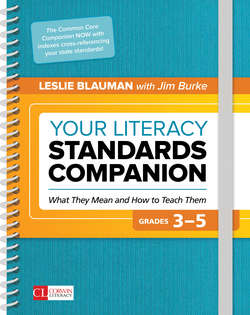Читать книгу Your Literacy Standards Companion, Grades 3-5 - Leslie Blauman - Страница 16
На сайте Литреса книга снята с продажи.
ОглавлениеCollege and Career Readiness Anchor Standards for Reading K–12
Source: Common Core State Standards
The 3–5 Reading Standards outlined on the following pages define what students should understand and be able to do by the end of each grade. Here on this page we present the College and Career Readiness (CCR) anchor standards for K–12 so you can see how students in grades 3–5 work toward the same goals as a high school senior: it’s a universal, K–12 vision. The CCR anchor standards and the grade-specific standards correspond to one another by numbers 1–10. They are necessary complements: the former providing broad standards, the latter providing additional specificity. Together, they define the skills and understandings that all students must eventually demonstrate.
Key Ideas and Details
1. Read closely to determine what the text says explicitly and to make logical inferences from it; cite specific textual evidence when writing or speaking to support conclusions drawn from the text.
2. Determine central ideas or themes of a text and analyze their development; summarize the key supporting details and ideas.
3. Analyze how and why individuals, events, and ideas develop and interact over the course of a text.
Craft and Structure
4. Interpret words and phrases as they are used in a text, including determining technical, connotative, and figurative meanings, and analyze how specific word choices shape meaning or tone.
5. Analyze the structure of texts, including how specific sentences, paragraphs, and larger portions of the text (e.g., a section, chapter, scene, or stanza) relate to each other and the whole.
6. Assess how point of view or purpose shapes the content and style of a text.
Integration of Knowledge and Ideas
7. Integrate and evaluate content presented in diverse media and formats, including visually and quantitatively, as well as in words.*
8. Delineate and evaluate the argument and specific claims in a text, including the validity of the reasoning as well as the relevance and sufficiency of the evidence.
9. Analyze how two or more texts address similar themes or topics in order to build knowledge or to compare the approaches the authors take.
* Please consult the full Common Core State Standards document (and all updates and appendices) at http://www.corestandards.org/ELA-Literacy. See “Research to Build Knowledge” in the Writing section and “Comprehension and Collaboration” in the Speaking and Listening section for additional standards relevant to gathering, assessing, and applying information from print and digital sources.
Range of Reading and Level of Text Complexity
10. Read and comprehend complex literary and informational texts independently and proficiently.
Note on Range and Content of Student Reading
To build a foundation for college and career readiness, students must read widely and deeply from among a broad range of high-quality, increasingly challenging literary and informational texts. Through extensive reading of stories, dramas, poems, and myths from diverse cultures and different time periods, students gain literary and cultural knowledge as well as familiarity with various text structures and elements. By reading texts in history/social studies, science, and other disciplines, students build a foundation of knowledge in these fields that will also give them the background to be better readers in all content areas. Students can only gain this foundation when the curriculum is intentionally and coherently structured to develop rich content knowledge within and across grades. Students also acquire the habits of reading independently and closely, which are essential to their future success.
Source: © Copyright 2010. National Governors Association Center for Best Practices and Council of Chief State School Officers. All rights reserved.
